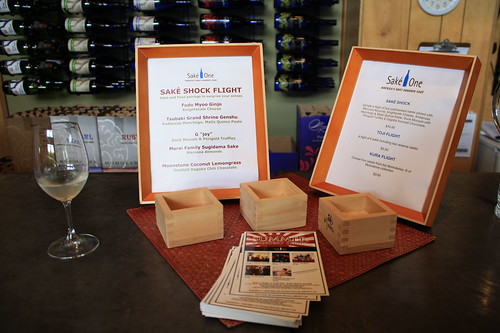For Goodness Saké

If visiting the heart of Oregon Wine County in the Willamette Valley of Oregon, one would certainly expect to find seemingly endless options for Pinot Noir. And, without mentioning it, one can always bank on a plethora of craft beer outposts to sate the unquenchable palate. Amongst the wondrous offerings available in this land of plenty a lone creator of distinct tipple resides-saké. Also known as rice wine, saké has a history a rich as beer from across the Pacific Ocean, where it is remains the national alcoholic beverage of Japan. Saké is in many ways similar to wine in its connoisseur culture surrounding it, and in many ways resembles beer relating to many aspects of its brewing process. In Oregon, a brewery of sake, or sakéry, exists in Forest Grove, not far from Portland in the land where the grape grows, the hop is heralded, and the barley is beloved.

SakéOne is Oregon’s sole sakéry, was incorporate in 1992 under the name Japanese American Beverage Company. The company was founded by an American named Grif Frost, who proved to be a true visionary in bringing this revered Japanese drink stateside. Through a partnership with Japan’s Momokawa Brewing Inc., a company producing saké since 1856, Frost began a formidable business as an importer. In 1998, the company changed its name to SakéOne and began not only importing, but producing saké. More than ten years later, SakéOne is producing some of the most revered saké in America including the Momokawa mainstay brand, the G premium undiluted Genshu brand, and the first ever infused saké known as Moonstone in 1999.
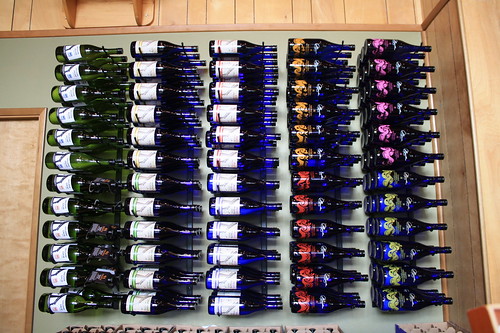
Today SakéOne remains the only American owned sakéry in the United States. Not only is the saké owned and operated in Oregon, USA, but its brewer Greg Lorenz is also the only American sakémaster. Lorenz, a biochemist with a background in plant biology and culturing, studied under Momokawa sakémaster Yoshio Koizum. On a recent trip to Forest Grove, Lorenz graced Brewpublic with a spectacular tour of the state-of-the-art SakéOne facility. We slipped on our sanitary booties and were able to get the grand tour. Kampai!
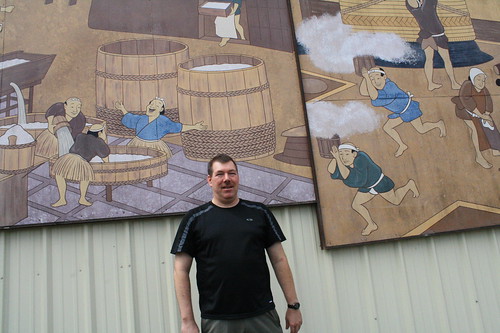
How did this amazing sakéry come to fruition in the United States, and of all place, Forest Grove, Oregon?
Greg Lorenz: To begin there aren’t any saké brewers here. They’re all in Japan, of course, and they all speak Japanese. They wanted to make it an American-forward type of sakéry, so they were looking for American people to do the work, so you naturally morph the technology. We are here because of that guy on that picture over there (points to a portrait of Tohru Murai). (Sakéone) was really his vision. He’s sixth generation Murai family. They own a very famous, well established sakéry in Japan. And he wanted a sakéry in the states. So he and a guy named Grif Frost joined up and did the entrepreneurial thing where they shelled out big bucks and got something started here. It’s pretty amazing how an idea turns into a physical reality.
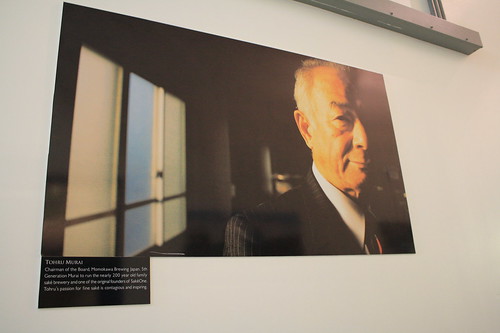
What kind of approach does SakéOne take from a cultural and technological standpoint?
Our technology is from their style of brewing in Northern Japan. Even though we call ourselves an American sakéry, we didn’t re-invent saké. We’re an American version of…when you take a technology and stick it into a different country it morphs. So by the idea of when we do our tastings, we taste with our taste buds-burgers and fries, not fish and rice. We’re going to select different kinds of sakés that appeal to our sort of culturalized tastebuds. There’s different cultural ideas about what good saké is. It’s really their technology. The yeast still comes from Japan, mold still comes from Japan, so some of the critical components are from there. So, we’ve sort of morphed their technology with our sort of influences.
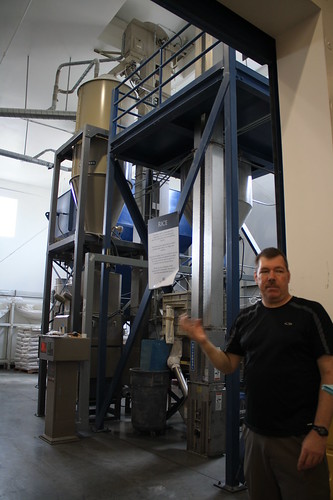
Lorenz kindly gives us a saké 101 tutorial and tour. Similar to beer in many ways, saké should in no way be confused and is very much its own animal.
The Water
GL: (Points to a big tank) This big tank has water in it. You’ve got to have good water or you’re not going to get good saké. They tested the water before they built the plant here and it turns out that the water coming off of the Coast Range is suitable. It’s kind of light, has some mineralization. It did spend a lot of time under ground.  You don’t want something that’s been so mineralized that it’s hard water. We add one or two minerals, but mostly, it’s fresh and light. It comes from Hagg Lake and it’s processed by the city. As it comes to us from the city, we’ve got some extra filtration steps there at the end. This is to make sure it’s suitable for us. We want to make sure there’s no iron. So, that’s a big deal. If you look at most of the waters where sakéries are, it’s pretty good, clear, pure water. Takara (in Berkeley, California) flows off of the Sierra Nevada mountain range, so they’re doing something similar to us. Some of the big areas in Japan stream water from the mountains. That’s important, that’s why we’re here. Grif Frost knew of this area where the water’s good and it also allows us to participate in the wine area. When people go out and tour wineries, they often say “Oh, let’s go out and do something else. Here’s a novelty.” We’re trying to be a part of the wine community.
You don’t want something that’s been so mineralized that it’s hard water. We add one or two minerals, but mostly, it’s fresh and light. It comes from Hagg Lake and it’s processed by the city. As it comes to us from the city, we’ve got some extra filtration steps there at the end. This is to make sure it’s suitable for us. We want to make sure there’s no iron. So, that’s a big deal. If you look at most of the waters where sakéries are, it’s pretty good, clear, pure water. Takara (in Berkeley, California) flows off of the Sierra Nevada mountain range, so they’re doing something similar to us. Some of the big areas in Japan stream water from the mountains. That’s important, that’s why we’re here. Grif Frost knew of this area where the water’s good and it also allows us to participate in the wine area. When people go out and tour wineries, they often say “Oh, let’s go out and do something else. Here’s a novelty.” We’re trying to be a part of the wine community.
Milling
GL: The first thing about saké, is you’ve got to mill the rice. There’s fats and proteins on the outside of the rice grain that do not lend themselves to good flavors. (Points to mill) was shipped all the way from Japan. It’s a little  bit like an hour glass. You load up 4,000 pounds of rice; there’s a roller stone that that grinds away the rice very gently, it goes to an elevator in the back. For a big machine, it does something very delicate. We want to shrink the rice. We don’t want to crack the rice into small bits. That doesn’t lend to good saké flavors either. This (mill) room is a good example of a morphing, a sort of engineering morphing. Some of the critical pieces of engineering come from Japan because they don’t make them in the States. The steel holding tanks are locally made by the wine industry. American engineers knew how to build the building to code and to spec, and then there were Japanese technicians who said “yeah, but we know how to brew it.” So those two had to come together to build this place. That’s a good symbol of what went on here.
bit like an hour glass. You load up 4,000 pounds of rice; there’s a roller stone that that grinds away the rice very gently, it goes to an elevator in the back. For a big machine, it does something very delicate. We want to shrink the rice. We don’t want to crack the rice into small bits. That doesn’t lend to good saké flavors either. This (mill) room is a good example of a morphing, a sort of engineering morphing. Some of the critical pieces of engineering come from Japan because they don’t make them in the States. The steel holding tanks are locally made by the wine industry. American engineers knew how to build the building to code and to spec, and then there were Japanese technicians who said “yeah, but we know how to brew it.” So those two had to come together to build this place. That’s a good symbol of what went on here.
American Saké Takes American Rice
GL: We get our rice in 2,000 pound bags from Sacramento. As it turns out, lucky for us, Sacramento has an area there that is very similar to rice growing areas of Japan. (In the Sacramento area), they’ll actually grow some of the eating rice and ship it back to Japan. So, they’re really on top of their rice. We’re pretty happy about that. We don’t have all of the specialty rices that they have in Japan, so we’re what you might call a vanguard outlier. It’s going to take us a while to develope rice grains and get stuff growing. We are in a process, but this takes many many years.
To give you an idea of scale, we’re going to be brewing 4,000 gallon batches. It takes one day to mill 4,000 pounds (two 2,000 pound bags) and we have to do that four times. So it basically takes four days to mill the rice for one batch. It’s quite an effort. We mill the whole grain, but we’re only going to use 60 percent of it. The other 40 percent is flour that’s whisked away and is picked up by a farmer that comes out of Tillamook. He mixes it in with cattle feed and it goes off and gets processed as dairy. We actually get little blocks of cheese every once in a while. (Smiles) So we help make a little bit of cheese.
Is there a special variety of rice used?
GL: It’s actually a U.S. short-grained rice. It’s pretty much a ubiquitous, used-for-everything rice. We’re going to make some different selections and changes. In Japan they’re very specific about which rice they use. We don’t have that sort of infrastructure that they do for that. We use whatever is available. I like the challenge. I call it the “terroir effect.” You take whatever is in your neighborhood, and can you make that good? The rice we use here does make decent saké. It doesn’t mean that I wouldn’t like to play around with more different rice types.

What’s the reception of your product been like in the Japanese market?
GL: They know we’re here. It’s pretty hard not to see that the U.S. is a pretty huge growth market for saké. The Japanese, as you can imagine are pretty good at entrepeneurism in their own right. As we collectively, with the Japanese importers, train and educate people of the joys of saké, it’s an all boats float kind of thing. Are we challenging them for quality? No. We’re decent. We’re value-priced. But the sakés coming out of Japan are just mindblowing. You’re going to pay for it, but when you taste those high end sakés, it is truly amazing. So, they’re not worried about us dominating the market, no no. We’re definitely small fry.
From Japan to the World: De-regionalizing Saké
GL: The general push is we think that the American market will accept saké as a drink rather than a regional drink. Tequilla started off as a regional drink from Northern Mexico. Scotch, at one point, started off as a regional drink from Ireland/Scotland. It came over to Tennessee, they made it there, and all of a sudden, it becomes deregionalized. Same is true of Vodka and so forth…We think we are going through that sort of process, and it takes decades. I think one of the most recent examples is California wines. Back in the ’60s if you had a California wine, it was like “Eww! Wine must be European.” But Europeans came over with European vines and started growing stuff in California. And decades later, it developed into its own entity. It is no longer perceived as European wine grown in California. No it’s now perceived as California wine. We think we’re still going to go through that same sort of process. Call me back in twenty years and I’ll tell you how we did. It’s a long, slow process.
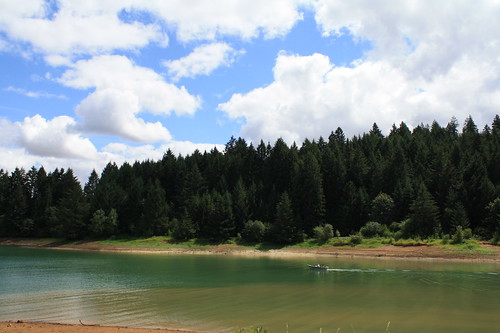
Koji
GL: To make saké, what we basically have to do is take a big, huge starch grain and feed a little, teeny, tiny yeast. So they can not eat the starch. What we have to do is break down that starch grain into individual glucoses. This little tube (points) is an auger system that brings the rice over here (from the mill room). There’s actually two tubes. One goes to the right, one goes to the left. We’re going to start to break down that starch and make it edible for the yeast. The right hand pathway is called liquification-water, rice, enzymes stir. It helps start breaking down the starches. It doesn’t break them down all the way but it helps start the process. (They yeast) start to truly start to digest the starches with koji.

Koji is where you get a mold spore and add it on to a rice grain and that mold actually grows into the rice and exudes enzymes that breakdown starches into glucose. That’s how you feed (the yeast). The lefthand pathway is more like a Powerbar. It breaks down proteins into amino acids. It basically pre-digesting nutrients and making them more available for the yeast when we actually start to brew. In beer what they do is take the seed out and partially germinate it so that the embryo sends the little enzymes out to break down the sugars, but not too much, and then stop it before it actually turns into a plant. But we can’t do that because the machinery, the life part of the plant is milled off. So we have to actually introduce a whole other organism to do kind of the same thing. The left hand pathway is all about growing mold. You take rice coming into this hopper and it has got flour on it from the milling. Two little whirlpools of water are going to wash off the excess flour and it goes up into our hopper. When we add the water it just goes right into the rice grain. What we’re trying to do here is 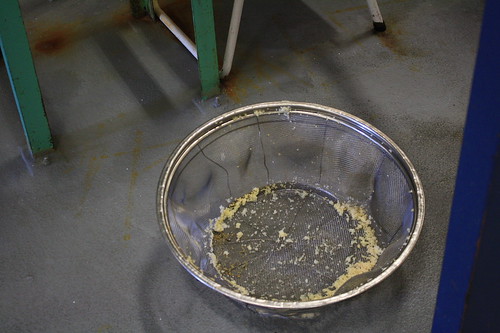 build optimum cultures. This means the right amount of water, the right amount of food to grow mold intentionally. From here we go to our steamer and steam for one hour. We do 800 pounds of rice at a time. After an hour, we tip the tray down into the hopper where we put mold spores on it. The problem with it is, if you put a mold spore on really hot rice, you’re just going to kill it. So we have another fancy piece of machinery from Japan that actually has a draw-down fan and a chainlink belt will allow the rice to go up the belt air will be drawn over it so it will actually cool it off. So between this hopper and about halfway up the hopper, it will go from 180 degrees (Fahrenheit) to 90 degrees. A lot of things will grow at 90 degrees. From here, we line up these conveyers to the other side where (in another room) we grow the mold.
build optimum cultures. This means the right amount of water, the right amount of food to grow mold intentionally. From here we go to our steamer and steam for one hour. We do 800 pounds of rice at a time. After an hour, we tip the tray down into the hopper where we put mold spores on it. The problem with it is, if you put a mold spore on really hot rice, you’re just going to kill it. So we have another fancy piece of machinery from Japan that actually has a draw-down fan and a chainlink belt will allow the rice to go up the belt air will be drawn over it so it will actually cool it off. So between this hopper and about halfway up the hopper, it will go from 180 degrees (Fahrenheit) to 90 degrees. A lot of things will grow at 90 degrees. From here, we line up these conveyers to the other side where (in another room) we grow the mold.
Inside the Koji Room
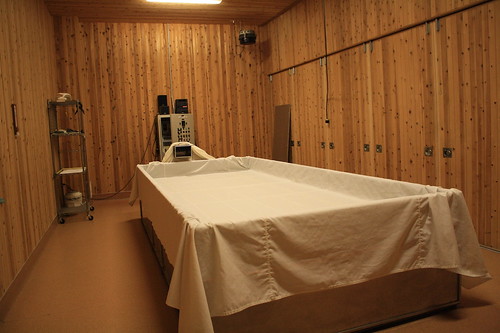
GL: Inside (the mold growing room) you get the feeling you’ve walked into a completely different a tyle of place. When they originallly designed this place, another thing they did to make this koji room traditional the walls 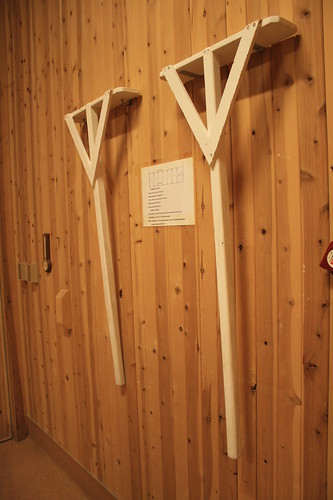 were cedar-lined. You get antimicrobial resins in the cedar. So we grow what we want to grow and not what happens to be floating on the walls and competing for the food. The idea is an old one but it is good. You can sanitize steel but the wood breathes humidity. It soaks it up and releases it. So, in this regard, the humidity factor is something that the wood does better than steel. What we do when we’re culturing here is hands-on. In the milling room, one person and a forklift can run the whole show. In here, we’ve got three or four people doing the different tasks by hand. We use little rakes to rake things out. The rice at this point is very soft and maleable. And although you can do these things by big automated systems, I think it is better to do this hands-on. There’s another room just like this on the other side (of the wall), and what we’re going to do in there is germinate. We take what just came out of the room with the steamer, we put the rice on a bed and keep it warm and cozy and in one day it’s going to germinate. If you think of seeds in the soil taking eight to ten days to germinate in the ground, this
were cedar-lined. You get antimicrobial resins in the cedar. So we grow what we want to grow and not what happens to be floating on the walls and competing for the food. The idea is an old one but it is good. You can sanitize steel but the wood breathes humidity. It soaks it up and releases it. So, in this regard, the humidity factor is something that the wood does better than steel. What we do when we’re culturing here is hands-on. In the milling room, one person and a forklift can run the whole show. In here, we’ve got three or four people doing the different tasks by hand. We use little rakes to rake things out. The rice at this point is very soft and maleable. And although you can do these things by big automated systems, I think it is better to do this hands-on. There’s another room just like this on the other side (of the wall), and what we’re going to do in there is germinate. We take what just came out of the room with the steamer, we put the rice on a bed and keep it warm and cozy and in one day it’s going to germinate. If you think of seeds in the soil taking eight to ten days to germinate in the ground, this 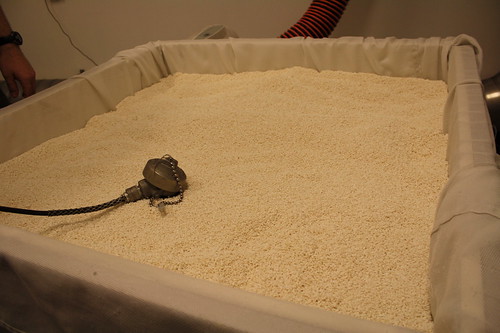 goes overnight. It’s very quick. It looks like a big burrito. We wrap it up nice and warm and in the morning you see little white flakes to indicate that the spores have germinated. We use its own biology to help grow it. We do that with the help of a controller and a fan. We lay out the rice and this room is warm, in the 90s. But some of the critical rice comes from the heat of the growth of the mold. Just like we produce heat because we’re alive, so does the malt. There’s a temperature probe that triggers the fan to come on at a set point, and the mold is still growing. We get this nice tight band in the 90s. We are trying to maximize the food potential for the yeast, which means you want to have lots of enzymes and you want to have things breaking down. I think there has been identified over 250 chemical eproperties in enzymes that will do different things. The biggies, of course, are break down the starch and break down a little bit of extra proteins, but there’s a lot of other things as well that can influence flavor. In one day this goes from an opaque looking grain to white. It is an earthy, slightly mushroomy smell, but not as pungent. Its kind of like mushroom-light maybe. Let’s go take a look at that.
goes overnight. It’s very quick. It looks like a big burrito. We wrap it up nice and warm and in the morning you see little white flakes to indicate that the spores have germinated. We use its own biology to help grow it. We do that with the help of a controller and a fan. We lay out the rice and this room is warm, in the 90s. But some of the critical rice comes from the heat of the growth of the mold. Just like we produce heat because we’re alive, so does the malt. There’s a temperature probe that triggers the fan to come on at a set point, and the mold is still growing. We get this nice tight band in the 90s. We are trying to maximize the food potential for the yeast, which means you want to have lots of enzymes and you want to have things breaking down. I think there has been identified over 250 chemical eproperties in enzymes that will do different things. The biggies, of course, are break down the starch and break down a little bit of extra proteins, but there’s a lot of other things as well that can influence flavor. In one day this goes from an opaque looking grain to white. It is an earthy, slightly mushroomy smell, but not as pungent. Its kind of like mushroom-light maybe. Let’s go take a look at that.
Moldy Rice
GL: This is our truth or dare portion of the show. It’s sugar powdery white. Just take a few grains and eat it. It should be chewy and a little bit sweet. Surprise surprise. The sweet is indicating that enzymes from the mold have done their thing. This is now good yeast food. Tomorrow we are going to mix it with yeast and start brewing.

How is saké similar to beer?
GL: It is similar to beer. We’re brewing with a grain but we’ve got our own method. We don’t do the malting step at all because we mill off the part that would be used for the malting of beer.
It takes a trillion cells of yeast to brew 4,000 gallons!
GL: This (rocketship-looking) thing takes one gram of yeast and turns it into 2,000 grams of yeast in 40 hours with the help of nutrients and good temperature control. It’s really a great device for ramping up your culture size-again another critical component that comes from Japan. So that’s the set up. We’re almost ready to brew.
In the Fermentation Room
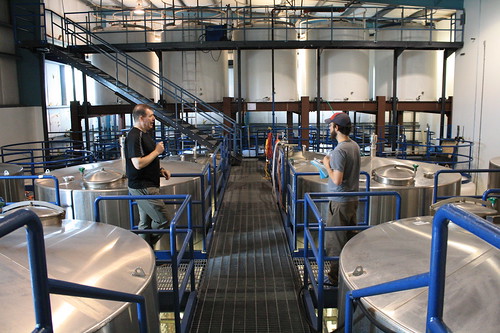
GL: 4,000 gallons from brewing. Usually a good smell of banana and citrus. This means the process is usually going well. This whole process take a week. From there it takes another five days from empty tank to full tank. So basically, the set up for full-on brewing takes two weeks. From the end of brewing (fermentation) takes another two weeks. We’re into it for five weeks for the brewing cycle. At the end of that, the alcohol is going to be between 18 and 19 percent. That’s pretty high for a brewed thing. Beers usually top out under 10 percent and wine usually under 15 percent.

From here a press takes the undigested rice material from the batch and push it through and circulate in so that it builds up a filter cake on the outside of rowed clothes. The filter cake with be thick enough that it will be pourage on one side and clear on the other side. It self-filters…a nice system. If you only go part of the way and dump the rest back into the batch, that’s how you get Nama. Nama is 3/4 filtered clear and the last quarter we roughly filter it. We take out all the big bits. It’s really quite similar to the brewed saké. From the press it goes out into the storage room. Again, this is a nice example of the sort of meeting of technologies. SakéOne’s steel tanks are from JV Northwest so they’re local. A series of white tanks are from Japan and are sort of the classic style. There’s iron on the outside and a porceline glaze on the inside. Both of them kind of do the same thing where they’re not participating in the flavoring of the saké. They’re neutral. The flavoring of the saké is coming from the enzymes themselves. We’re going to let them sit in a tank for about four to six weeks. We want to balance rice flavors with yeast flavors. A lot of the critic flavors that people call “tasty” are really coming from the yeast. Rice is sort of smooth, mellow, rounded where the yeast is going to produce things like floral smells, fruits, melon notes, peppery things, spices…those all come from the yeast. So what you want to do for good saké is balance those two out between the rice flavor and the saké flavor. About the four month mark is a good balance. If you keep going, the rice flavors tend to dominate over time. Saké is a drink fresh item-there’s another beer link.
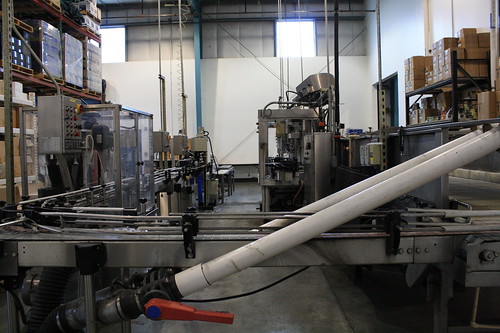
Is the yeast used similar to that used to brew beer?
Yeah. It’s related but you know how it is, it’s kind of like roses. It’s like “that’s a rose and it’s yellow and that’s a rose and it’s red.” They’re both roses, but they’re not exactly the same rose. So they select for characteristics over time and the Japanese selected for characteristics for saké. Beer brewers select characteristics for beer. Technically they are the same genus but they have phenotypic differences.
You guys are great. Keep up the great saké brewing!
GL: There’s a little of us in a big huge country. We’ve got a way to go.
